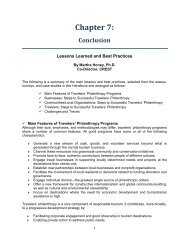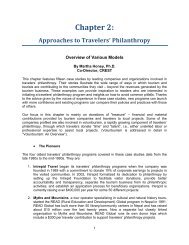Travelers' Philanthropy Handbook - Center for Responsible Travel
Travelers' Philanthropy Handbook - Center for Responsible Travel
Travelers' Philanthropy Handbook - Center for Responsible Travel
You also want an ePaper? Increase the reach of your titles
YUMPU automatically turns print PDFs into web optimized ePapers that Google loves.
Survey of Recipient Organizations in Arusha, TanzaniaBy Jessie DavieIndependent Consultant, Arusha, Tanzania• IntroductionWhether they are high-end tourists or backpackers, many travelers who are visiting northernTanzania today, specifically the Arusha Region, are engaging in philanthropic activities thatcompliment their travels. Arusha serves as the jumping off point to Tanzania’s famed northerngame circuit including the Serengeti, Ngorongoro Crater, and Mt. Kilimanjaro, among otherworld class attractions. Many tour operators based in Arusha are promoting certain communityprojects or organizations by arranging <strong>for</strong> tourist visits to project sites, providing visitors within<strong>for</strong>mation, and collecting donations. Some travel companies have begun specializing inplacing travelers with an interest in volunteering at specific projects. In addition, some nonprofitorganizations directly promote traveler involvement by welcoming tourists to their sites,providing volunteer opportunities, andusing their websites to educate and attracttravelers. In total, these ef<strong>for</strong>ts by tourcompanies and travelers to assist localorganizations in addressing some ofnorthern Tanzania’s pressing social andconservation needs constitute a robustexample of travelers’ philanthropy.The case study by Johanna Wolff (“Surveyof Tour Operators in Arusha, Tanzania” inChapter 4) based on surveys with 27 touroperators, demonstrates that many tourismbusinesses in the Arusha area havetravelers’ philanthropy programs. However,the importance of these programs andTourists sharing lunch with students, Arusha, Tanzania.Credit: The School of St. Judetheir impact on the recipient organizations was not clear. There<strong>for</strong>e, in early 2010 the <strong>Center</strong> <strong>for</strong><strong>Responsible</strong> <strong>Travel</strong> (CREST) commissioned this study to assess the actual benefits generatedby travelers’ philanthropy in Arusha and to assess how visitors’ donations could be utilized mosteffectively. Eleven organizations were surveyed, all of which are working with tour companiesto receive donations, material goods, and/or volunteers. These included schools and otherlearning centers, orphanages, and human and land rights organizations.All the organizations surveyed view this financial assistance as positive and vital to the runningof their organizations. In addition, some organizations rely on tourists to become volunteers orto bring needed materials and supplies from their home countries to a project site. This surveyprovides, <strong>for</strong> the first time, in<strong>for</strong>mation about the range and level of gifts received fromphilanthropically-oriented travelers to northern Tanzania and, how travelers get involved insupporting local organizations and causes. It suggests that certain types of donations moreeffectively support the work of local organizations’ work, while other types are less useful. Takentogether, the results of this study offer important guidance <strong>for</strong> organizations accepting travelers’philanthropy.167















